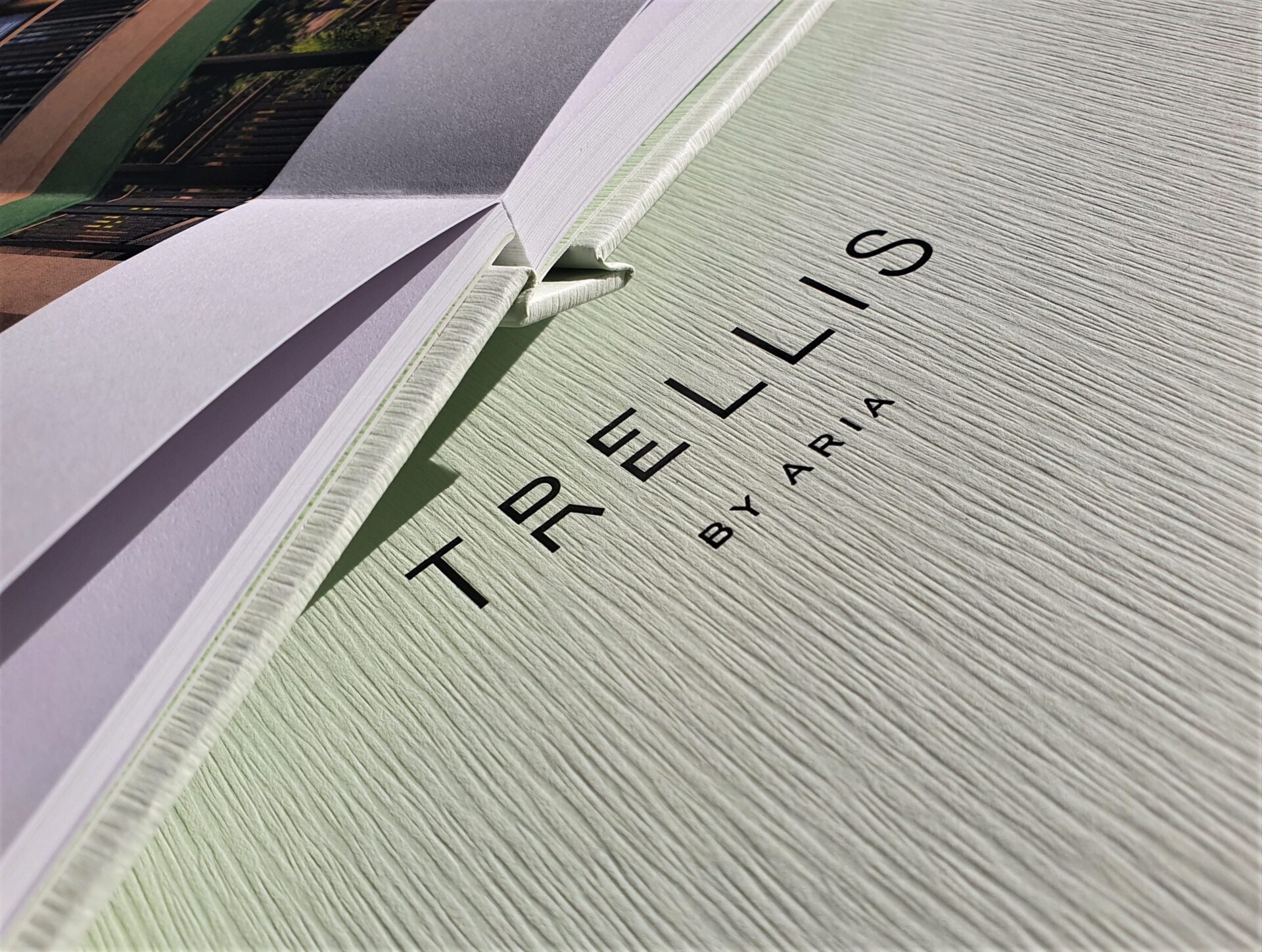
Trellis
Trellis is a stunning Brisbane development by Aria Property Group, with the creative done by Sexty Design. They used a beautiful lay-flat bind brochure to full effect with embossed colour plan endpapers and covers and a black foiled logo.
Interested in creating memorable printing through edge gilding? We’re dedicated to creating beautiful, eye-catching print.
That’s why we proudly employ the most sophisticated innovations available to us, and constantly refine our techniques to give you the perfect choice for your printing needs.
We understand that people these days are inundated with so much printed material that it’s vital to stand out from the crowd. We aim to do so with the sheer sophistication of our finish.
Read on to find out more about edge gilding process.
Edge gilding is a highly specialised process which adds a wonderfully elegant touch to a brochure, business card or invitation. Edge painting creates a similar effect.
Gilding is a process which has been around since ancient times, dating back as far as the ancient Egyptians. Throughout history, it has been reserved for only the most important of texts, due to its difficulty and cost. It was also traditionally done by hand—a thoroughly time-consuming process!
Edge painting is a more modern development. Instead of using metallic foil, the edges of the pages or cards are painted.
This is not quite as elegant a method, as it is done by hand and some colour can bleed into the pages. However, it does offer a huge range of colours.
When edge gilding, or edge painting, the chosen sheets of paper or card are trimmed and then the edges are carefully sanded down to create an extremely flat and even finish.
This fine finish is a vital step to create the ideal surface for gilding or painting.
The next step for gilding is to use a specialised rolling machine which presses extremely thin layers of metal foil against the prepared edge with a heated roller under high pressure.
This process sticks the foil firmly to the edge of each individual page or card, leaving each edge with a beautifully finished surface.
When it comes to edge painting, after cutting and sanding the sheets are clamped together.
Next a ‘brayer’ paint roller is used to carefully apply your desired colour to the edge. Once this paint dries, the next edge gets its colour coating, and so on.
The end result is not as shiny and decadent as gilding, but still creates an eye-catching finish to any corporate invitation or brochure.
Thicker papers will, of course, give a more impressive effect when edged. Generally, paper of about 250gsm and up is recommended for edge painting. Gilding, on the other hand, works well even on thinner paper, which makes it popular for the printing of fine books and brochures.
Traditionally, edge gilding was only done in gold, using ultra-thin gold alloys. These days though, the technology has advanced to allow us to offer three metallic colour options; copper, gold and silver. This means that you can choose a gilt edge that best matches your own colour scheme or branding.
If you’re looking for even more colour options, edge painting may be right for you. With this technique we can offer a full range of colour choices. Keep in mind that darker, more saturated colours tend to show up best when edge painting.
We want your printed material to last as long as possible. It’s therefore nice to know that edge gilding has a practical advantage also, in that the metal edges protect the product from damage in its day-to-day use.
With a gilded edge, the most delicate part of a page or card is sealed against moisture and dirt, meaning you won’t have to worry about ragged edges on your finely printed products. This is part of the reason why, historically, edge gilding was used for precious texts such as bibles.
Both edge gilding and painting are simple details which add a powerful visual impact to your printed material. Edge gilding is fast becoming the benchmark in high end bespoke stationery.
These techniques add a weight and importance to a corporate invitation, business card or business brochure that will set your brand apart from the rest. Both methods can also be combined with other embellishing touches, such as embossing, for ultimately tasteful printed material.

Trellis is a stunning Brisbane development by Aria Property Group, with the creative done by Sexty Design. They used a beautiful lay-flat bind brochure to full effect with embossed colour plan endpapers and covers and a black foiled logo.

Tom Dooley Developments used an exceptional range of x7 different brochures present Argyle, New Farm, with each apartment type and penthouse brochure using the unique Artis Layflat bind for seamless presentation.

Long Pocket is a classy collaboration between PHNX Digital and developer Shayher Group. Situated in the lovely Indooroopilly suburb of Brisbane, it uses a beautiful Artis Layflat brochure to display the stunning creative to maximum effect.